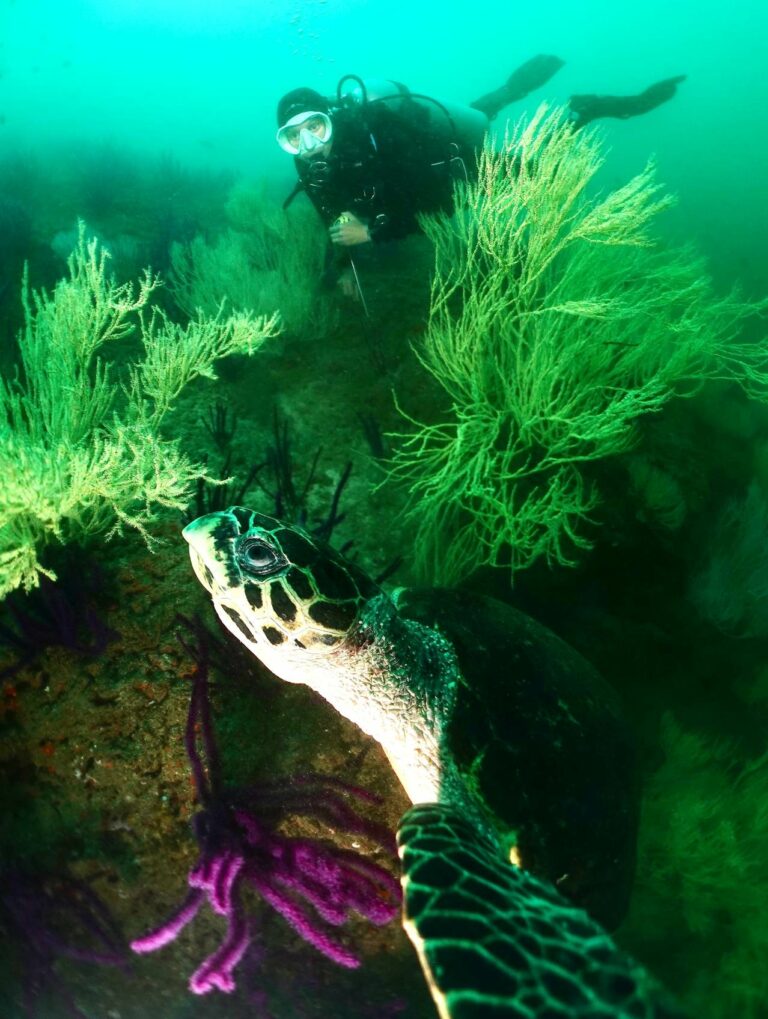Join PIERRE CONSTANT as he explores the reefs and wrecks of underwater Oman during a recent tour with his camera of the northern parts of the kingdom
Lauren Davies, the Welsh manager of Musandam Discovery Diving, is all smiles when we meet at Khasab airport. I’m driven to the staff villa, also the company’s guesthouse, on the edge of the port city.
Conveniently located on a water channel, the dive-centre itself is downtown, not far from the dhow port from which all tourist cruises depart.
Khasab’s only dive operation, Musandam Discovery Diving was founded in late 2015 by friendly Bader, a big bearded fellow with respectable corpulence who also works in the oil and gas industry. He wears the traditional white dishdasha robe with kummo (prayer hat) and mussar (red and white turban).
“You’ll be able to dive with Bader on Saturday,” says Lauren. “He is a very busy man – but very fond of nudibranchs!”

Part of the Arabian Peninsula, Oman’s 3,000km coastline is fringed by the Arabian Sea in the south-east, the Gulf of Oman in the north-east and the Persian Gulf in the north-west. US ichthyologist John E Randall has reported 1,179 fish species in its waters, 29 of them endemic.
Oman is mainly a gravel desert plain, but along the north-east coast lies the Al Hajar mountain range, with the Dhofar mountains to the south-east. The capital is Muscat, and immediate neighbours are Saudi Arabia, the UAE and Yemen, with Iran to the north across the Strait of Hormuz.
Oil was discovered in Dhofar in 1964, and from the 1970s Sultan Qaboos bin Said opened up and modernised the country. He was succeeded in 2020 by his cousin Sultan Haitham bin Tariq.
Isolated far to the north of the rest of Oman between the UAE’s claws, the mountainous Musandam peninsula is a separate enclave, 90km long and 35km wide. It’s the product of ancient Permian limestone and a thick Jurassic and Cretaceous carbonate shelf.
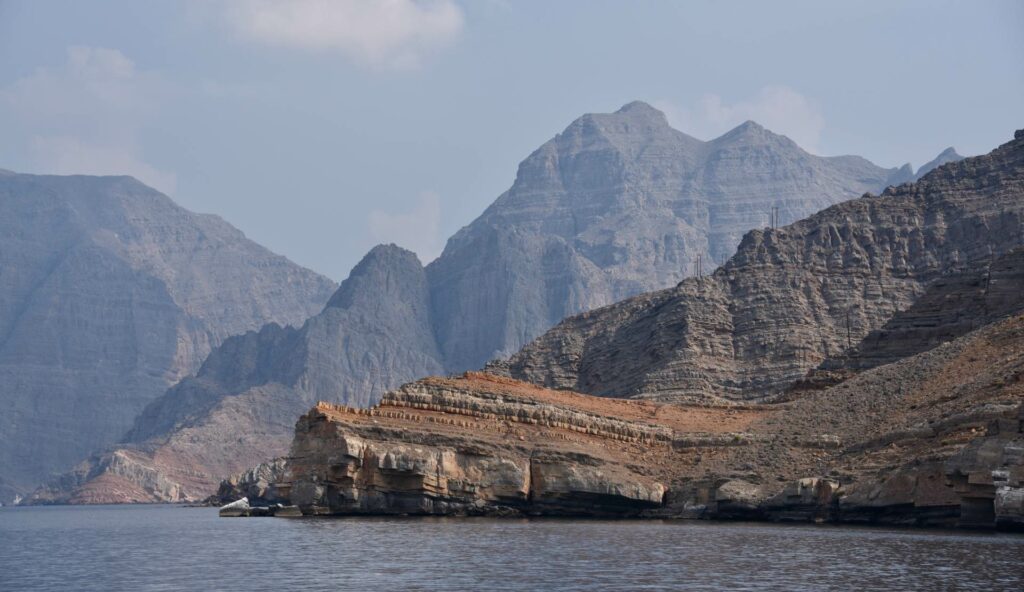
Pale grey and reddish, the rock here consists mainly of hard dolomite. I have transferred straight to Musanadam following my international flight to Muscat.
The Aquarium
The dive-centre looks very professional, with its classroom and a convivial wooden terrace overlooking the water. The dive-boat is an 11m Sinbad glass-fibre speedboat with twin 225 Mercury outboards and tank-racks, and comfy benches at the sides that can accommodate up to 10 divers.
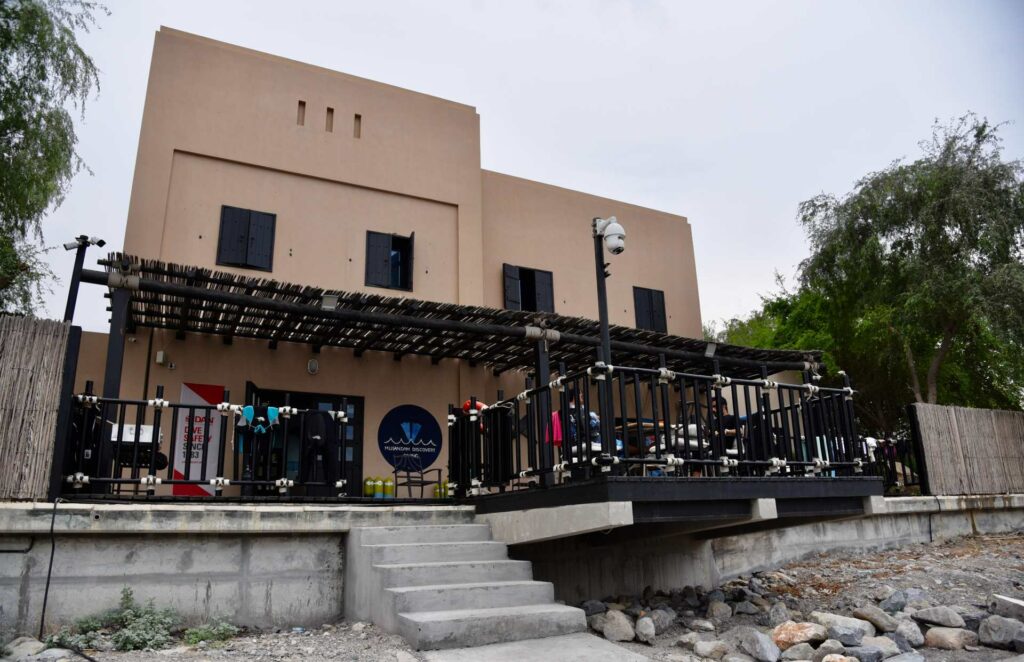
Calton the instructor and his wife Tasnee, a divemaster, are from Kerala in south India. Hamud, the first captain, is from Oman and speaks English, while the other captain Mahesh speaks Arabic fluently, having worked as a fisherman for many years.
Lauren drives me to the main port, to the gigantic Lulu hypermarket near the dive-shop and, finally, to the old Khasab Castle. This 17th-century Portuguese fort, refurbished by the Omani sultans, features interesting historical, geological and natural history displays.
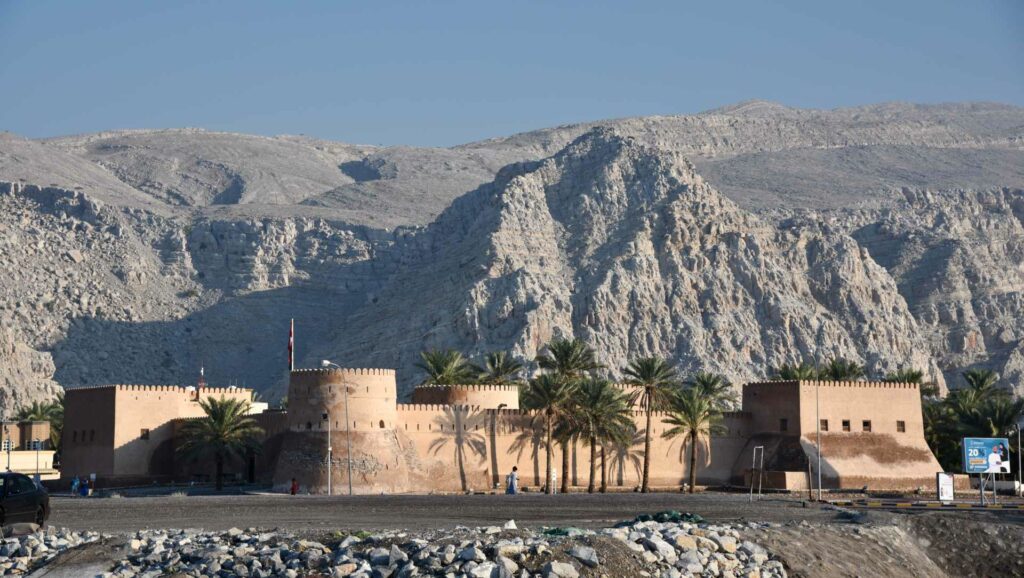
Strolling around the walls, visitors are greeted by mynahs, pigeons and joyful green, black and rose-ringed parakeets that nest in holes or play in the palm trees. It’s a must-see attraction, but a heavy downpour forces us to retreat inside. Some of Khasab’s streets are flooded in no time.
The Aquarium dive-site lies below a Cretaceous cliff at the entrance of Khawr (fjord) Ghubb Ali. The temperature is a balmy 30°C. Underwater visibility is poor today, the sea full of particles and the rocky bottom uninspiring.
Fish are present, however, mostly yellowbar angelfish (Pomacanthus maculosus), schools of long-spot snapper (Lutjanus fluviflamma), parrotfish and what looks like a peacock grouper.
A regional endemic, the yellowfin hind (Cephalopholis hemistiktos) proves rather shy. A cow-tail sting ray (Pastinachus sephen) gazes at me stoically from the sandy bottom.
The Humsi wreck
At the entrance of Khawr Shamm, the next dive is on the Humsi wreck, a rusty 10-11m fishing barge deliberately sunk in 10m some years back. Closer to Khasab, the visibility here is that of pea soup.
“The sea has been rough lately – it’s been raining too,” explains Calton. I notice a school of Arabian monocle bream (Scolopsis ghanam) and another of variable fusiliers (Caesio varilineata). A little group of pearly goatfish (Parupeneus margaritatus) rest on the deck.
Two shrimp gobies are on the look-out at their sandy burrow entrance. A short distance from the wreck, some metallic pyramidal structures have been positioned to help in replanting staghorn coral.
Next day’s dive is cancelled because of strong winds, so it’s suggested that we go on a dhow cruise in Khawr Shamm. This is very scenic, offering great views of those Musandam cliffs and fishermen’s villages. It also provides an opportunity to watch a normally elusive Indian Ocean humpback dolphin (Sousa plumbeus) as it follows the boat, porpoising playfully.
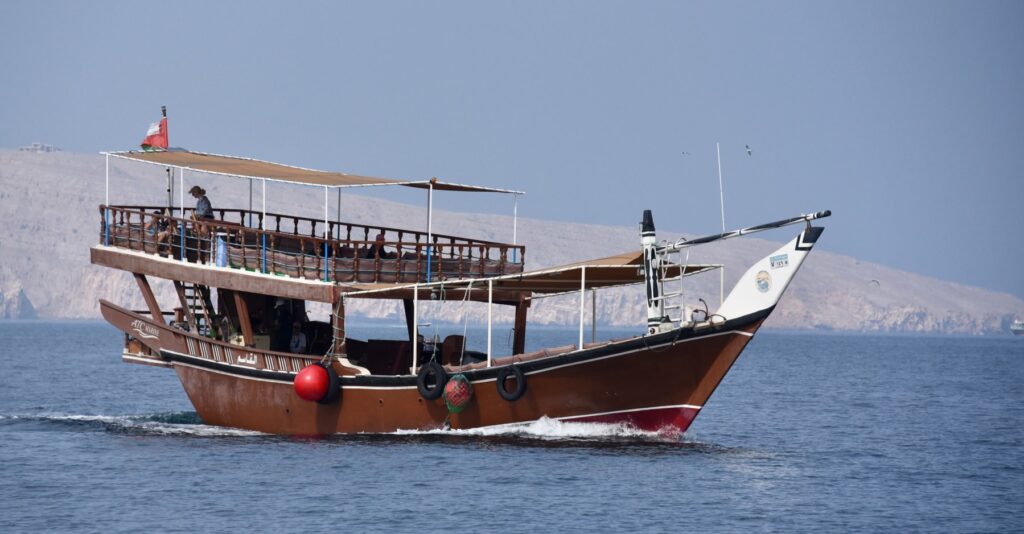
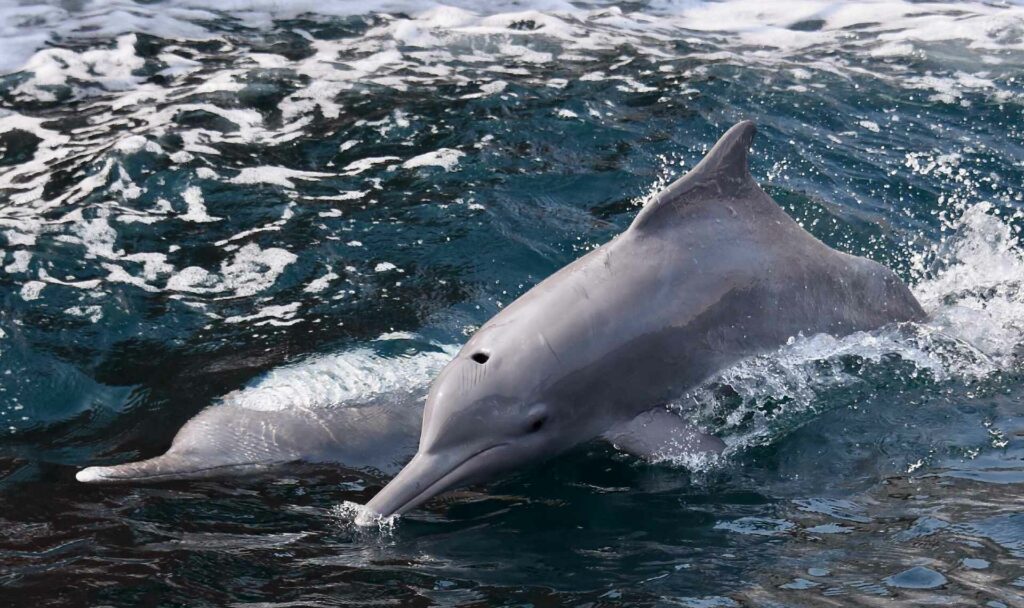
Two main bodies of water seem to be at work in Musandam: Persian Gulf water flowing from north-west to south-east into the Strait of Hormuz, and Indian Ocean surface water, flowing from south-west to north-east along the Oman coast from Salalah to Ras Hadd, with a diversion into the Gulf of Oman along the coast of Iran.
Coral Garden & Cat’s Eye
The northern part of the peninsula is accessed via Khawr Al Quway, a fjord that separates the military island of Umm al Ghanam from the mainland. The water is clearer and underwater visibility better here, where the weather is more stable.
Coral Garden (Abu Sir Island) lies at the base of a limestone cliff. At a depth of 20m, the surprise is to find blue-purple gorgonians and yellow bushes of black coral (Antipathes sp).
The water is still greenish. I see yellowbar angelfish, yellowfin hinds, variable fusiliers, gold-spotted jack (Carangoides bajad) and the regional endemic Arabian butterflyfish (Chaetodon melapterus), yellow with a black bar on its face.
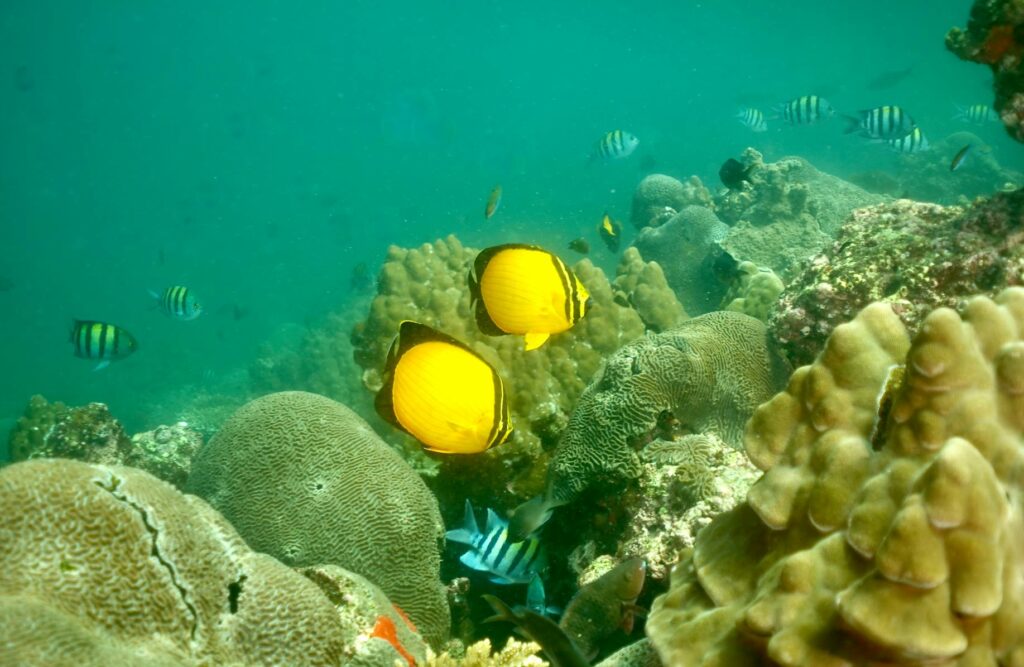
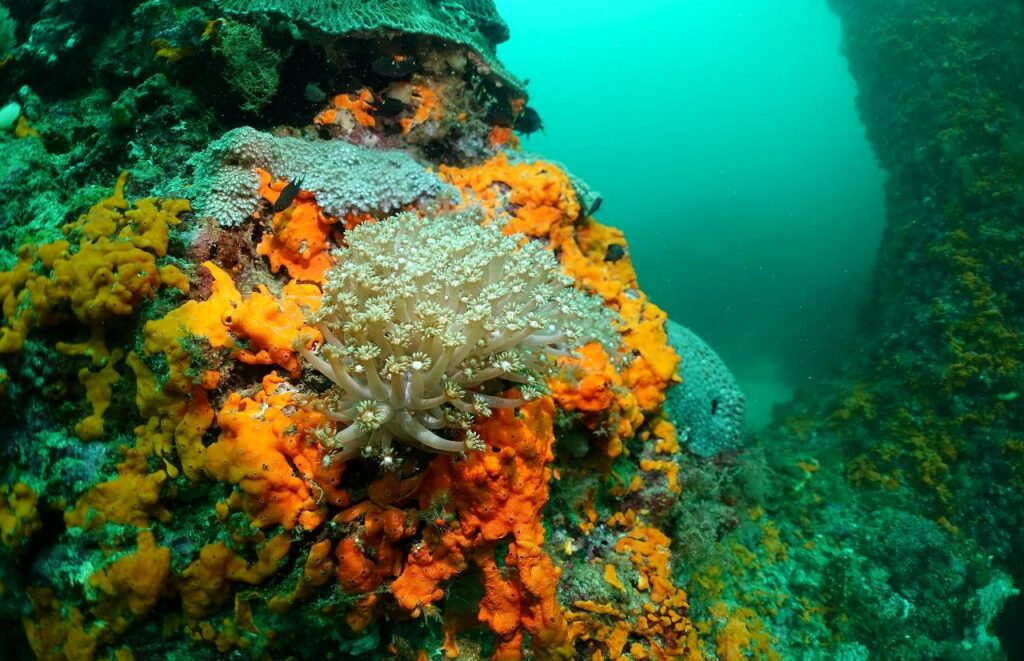
Black-spotted butterflyfish (Chaetodon nigropunctatus) are common, and schools of three-spot dascyllus (Dascyllus trifasciatus) and silvery-grey sordid sweetlips (Plectorhinchus sordidus) roam at depth.
A 30-minute boat-ride out to Al Khayl Island brings us to the conspicuous Cat’s Eye limestone rock formation. Many hard corals are found here: Porites, Acropora, Montipora and Pavona, along with plentiful fish life.
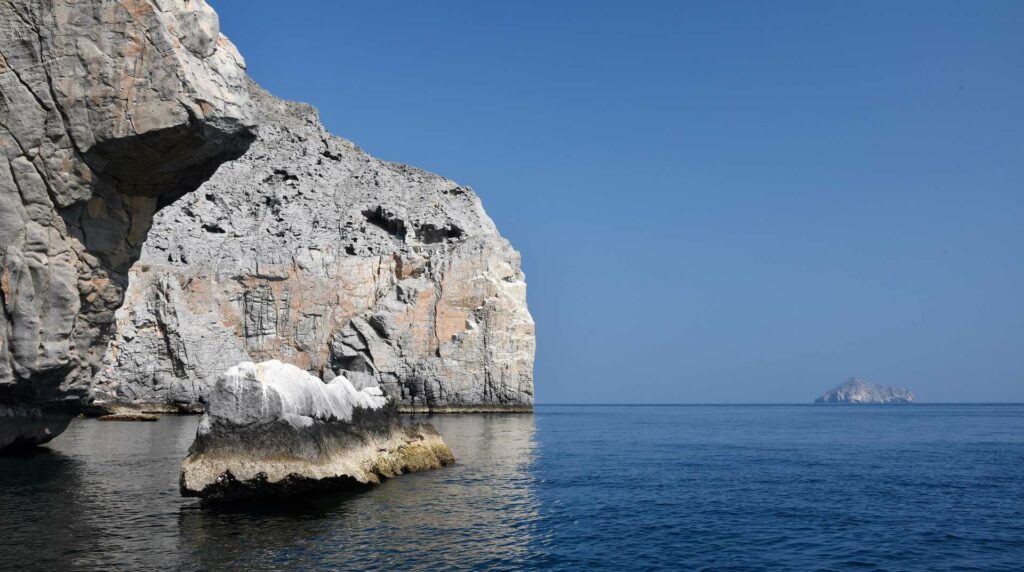
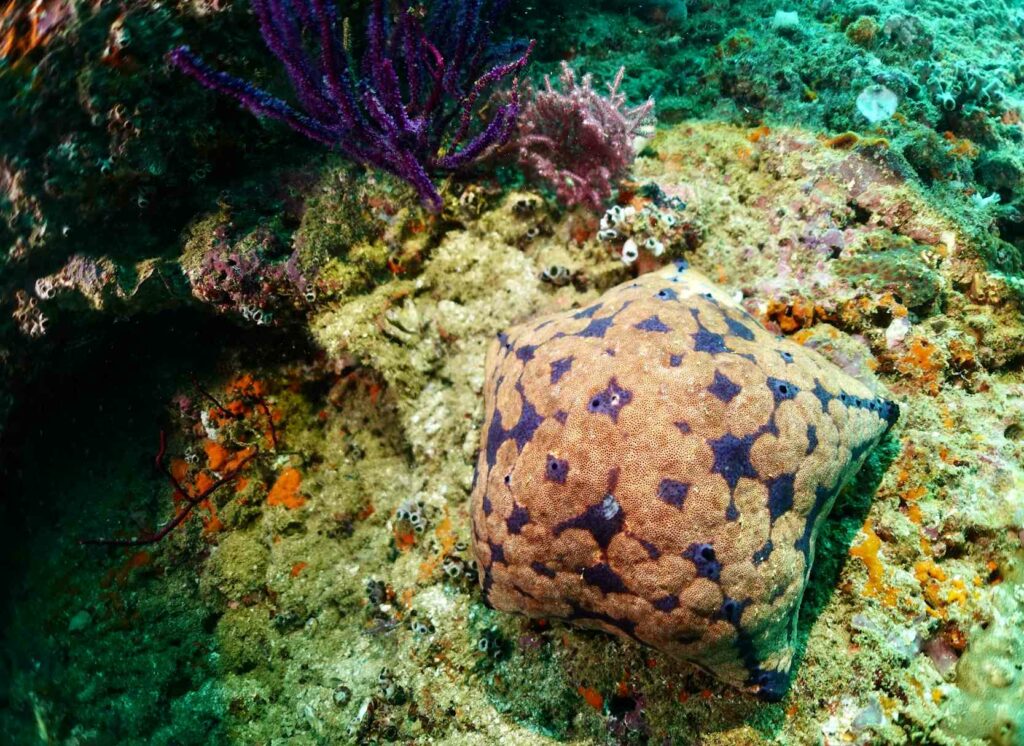
Pretty cushionstars (Culcita coriacea) lie on the sand, as do the blue-black predatory crown of thorns (Acanthaster planci) that cause considerable damage in Musandam. At a depth of 15m a slight eastward current makes itself felt, and a Hypselodoris pulchella nudibranch catches my eye.
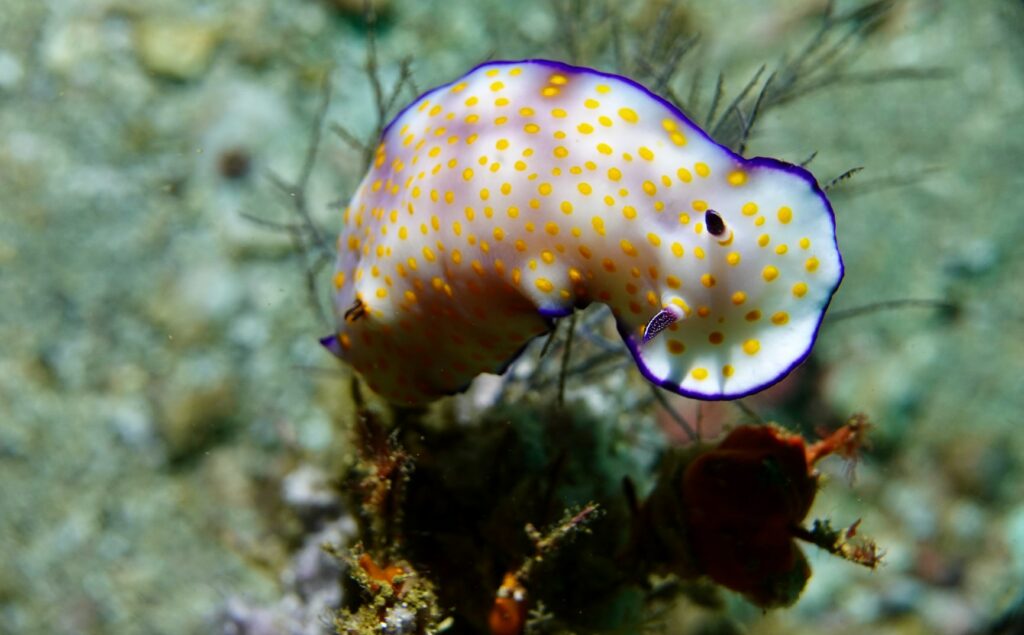
Al Batinah & No Palm
Behind Cat’s Eye is a secluded cove where the Al Batinah, a 15m Oman Navy patrol boat, was sunk in February last year after 30 years of service. It sits upright in the sand at 22m, and red and orange encrusting sponges have already covered the edges of the deck, bright against an eerie apple-green background.
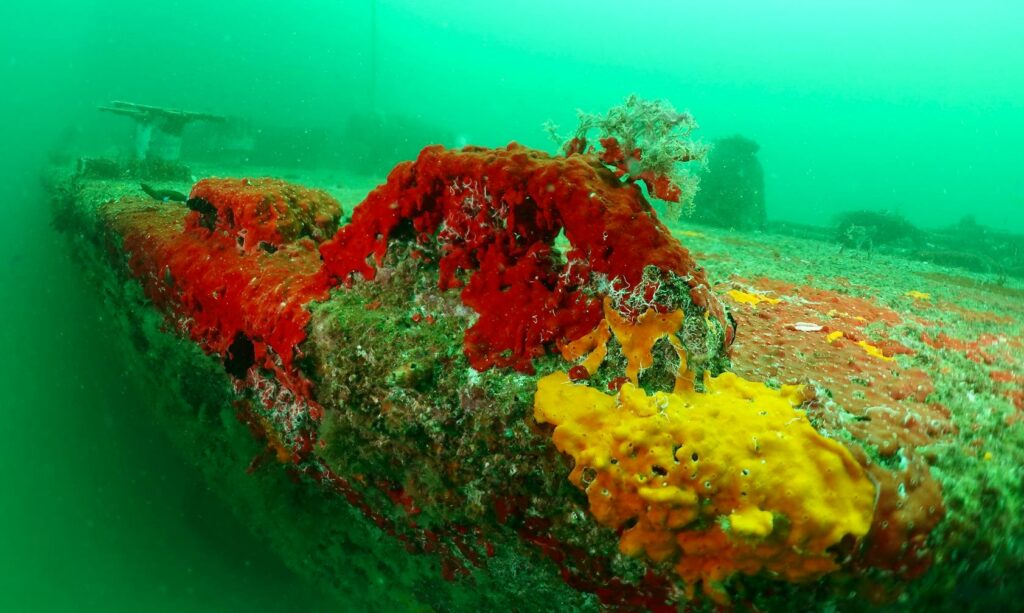
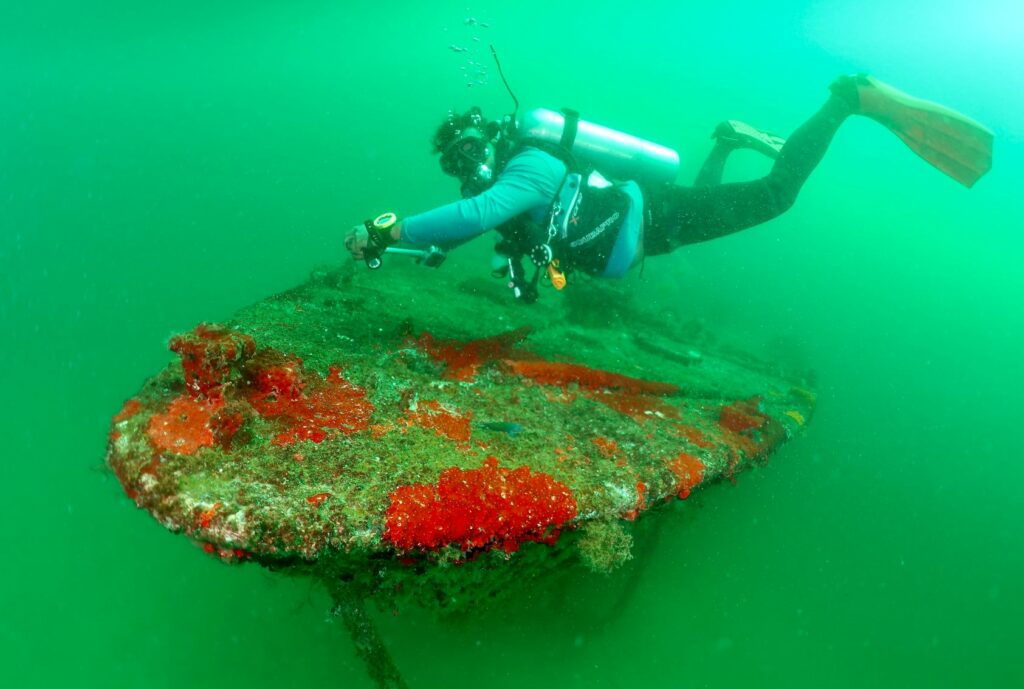
Penetration is possible in the hold, as well as in some of the corridors. Yellowbar angelfish are present, along with a pair of round batfish (Platax orbicularis), two-bar sea bream (Acanthopagrus bifasciatus) and some pennant coralfish (Heniochus diphreustes).
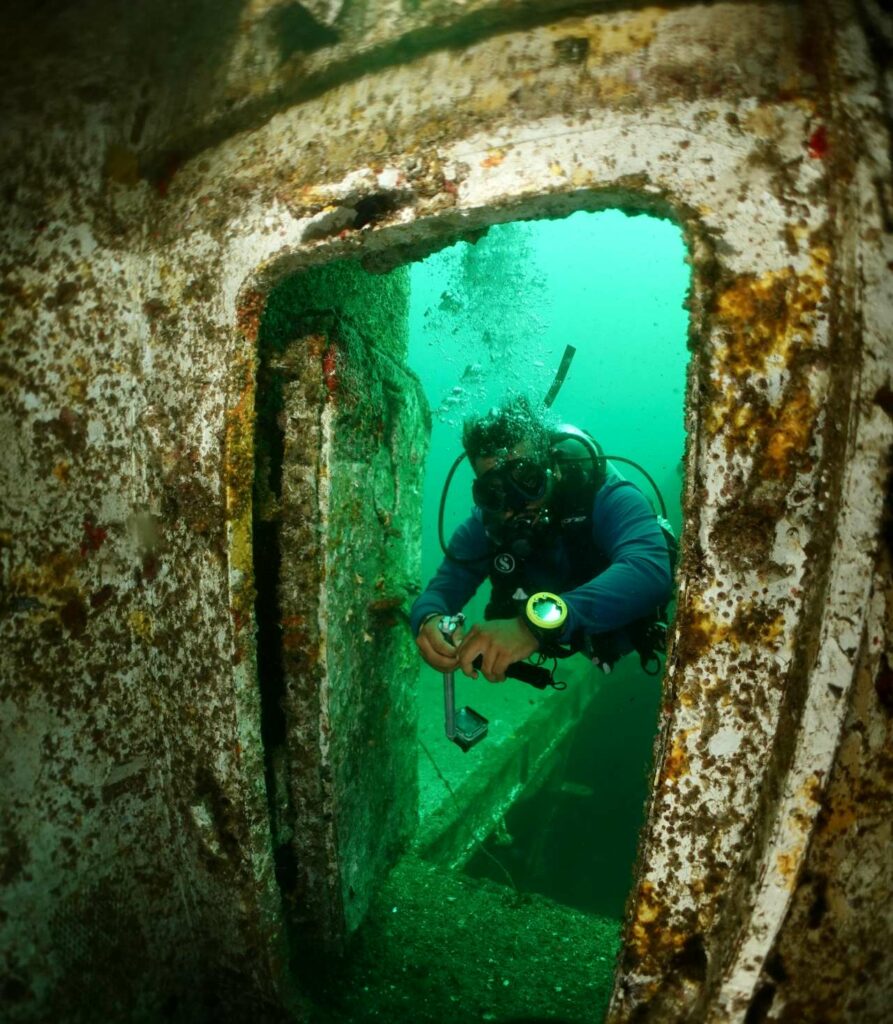
At weekends, expat divers like to come here from Dubai, a two-hour drive away. Bader, the dive-centre owner, shows up on Saturday.
East of Musandam Island, No Palm is a little beach in a secluded bay surrounded by mountains. At Smirnoff Point, an illegal shipment of vodka bottles was once dumped by smugglers trying to escape the Coast Guard, and was later found by divers.
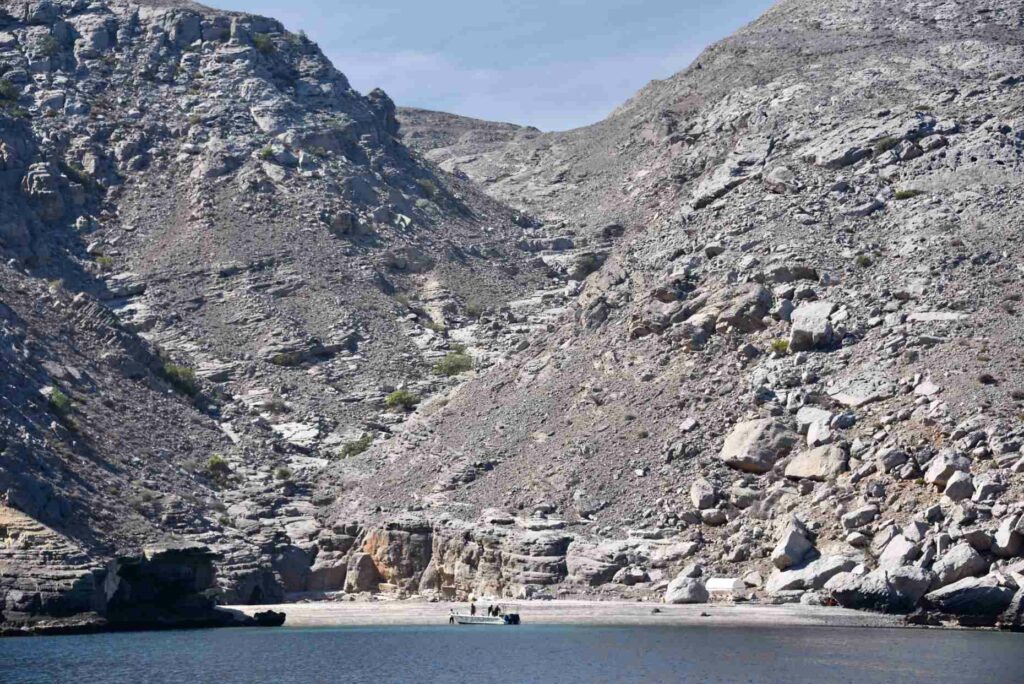
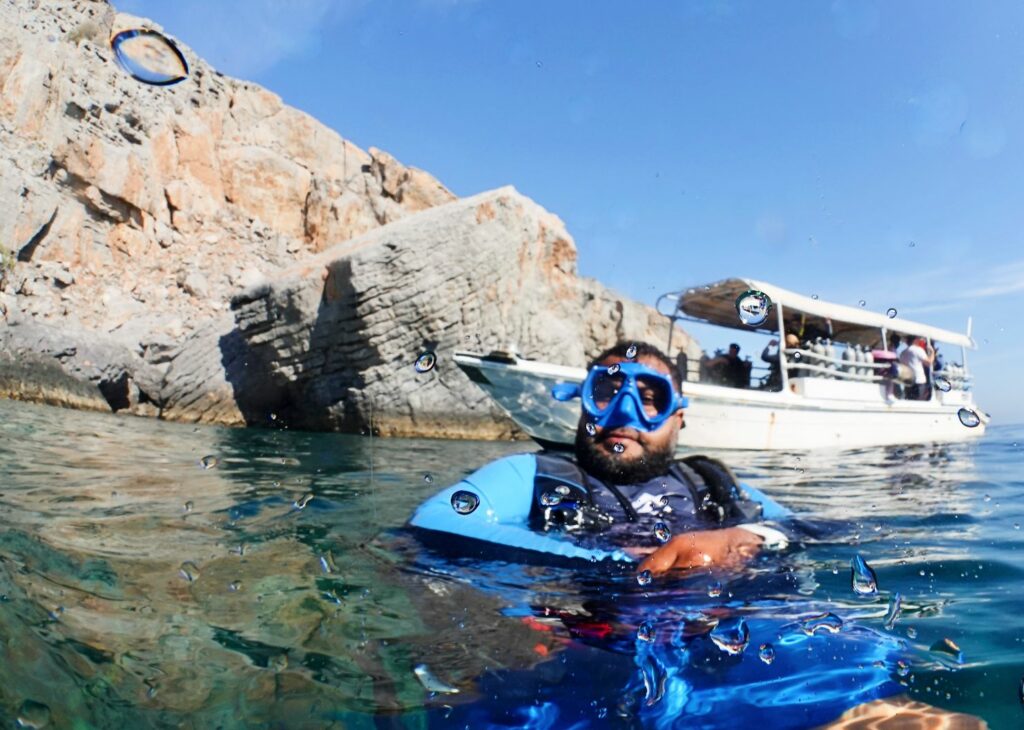
The water looks clear from the surface, but again turns out to be misty at depth. Huge boulders and black coral bushes host giant oysters in clusters. Bader points out a yellow-mouth moray (Gymnothorax nudivomer), brown with white dots. Round batfish hide under a ledge.
Rusty parrotfish (Scarus ferrugineus) roam around as Sohal surgeonfish (Acanthurus sohal) forage in the shallows. Two-bar sea bream are common.
Abu Rashid
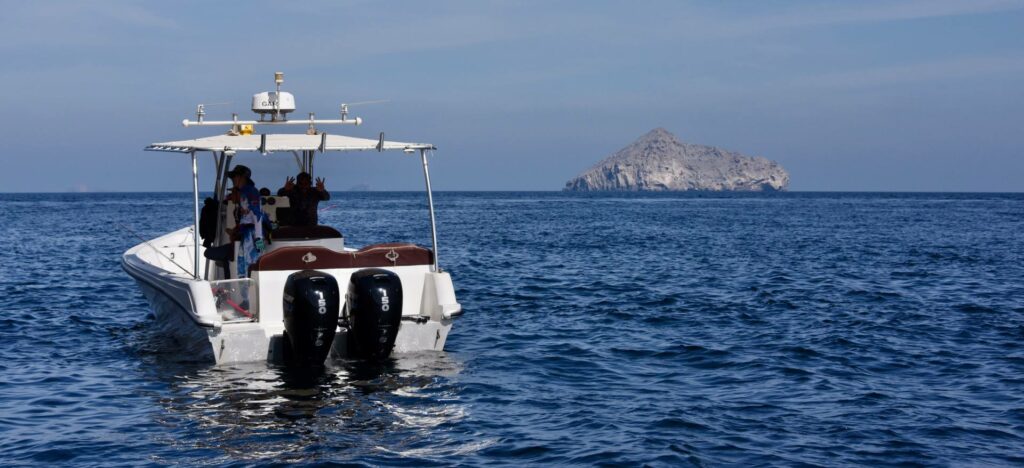
Musandam Discovery Diving visits up to 24 dive-sites around the peninsula, but the best are found at the northernmost island, Abu Rashid, its west side a succession of slopes and ledges.
Black coral bushes decorate the depths. In the shallows lie an enchanting prairie of Dendronephthya klunzingeri soft corals in yellow and white, with patches of red sponges in between. The fish seems tame, and the visibility is improving.
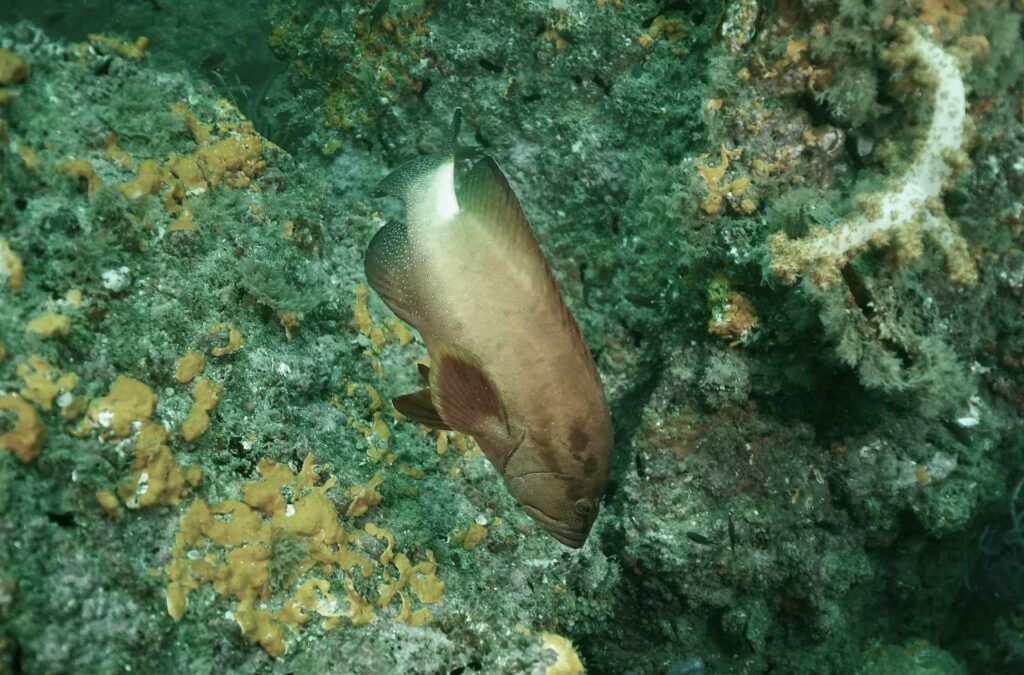
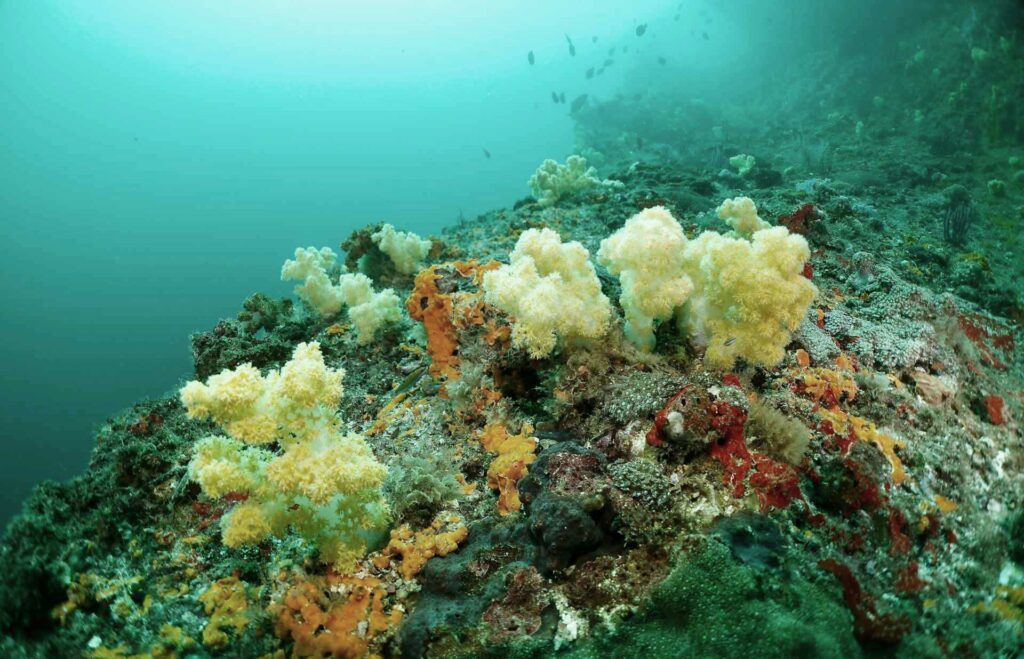
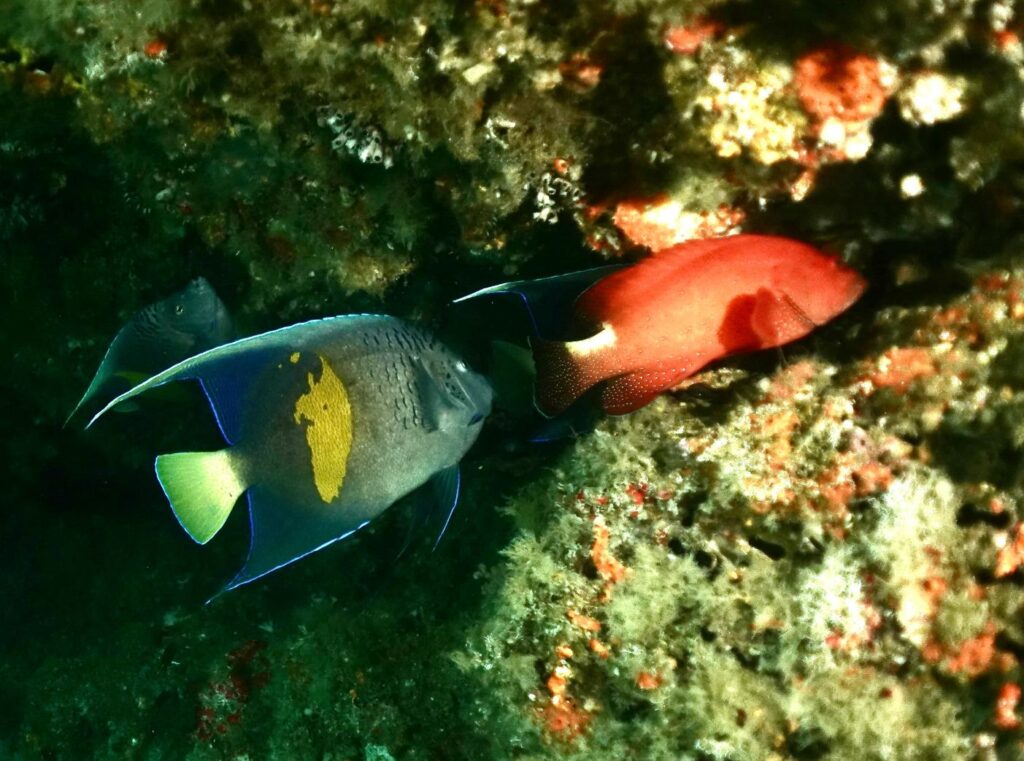
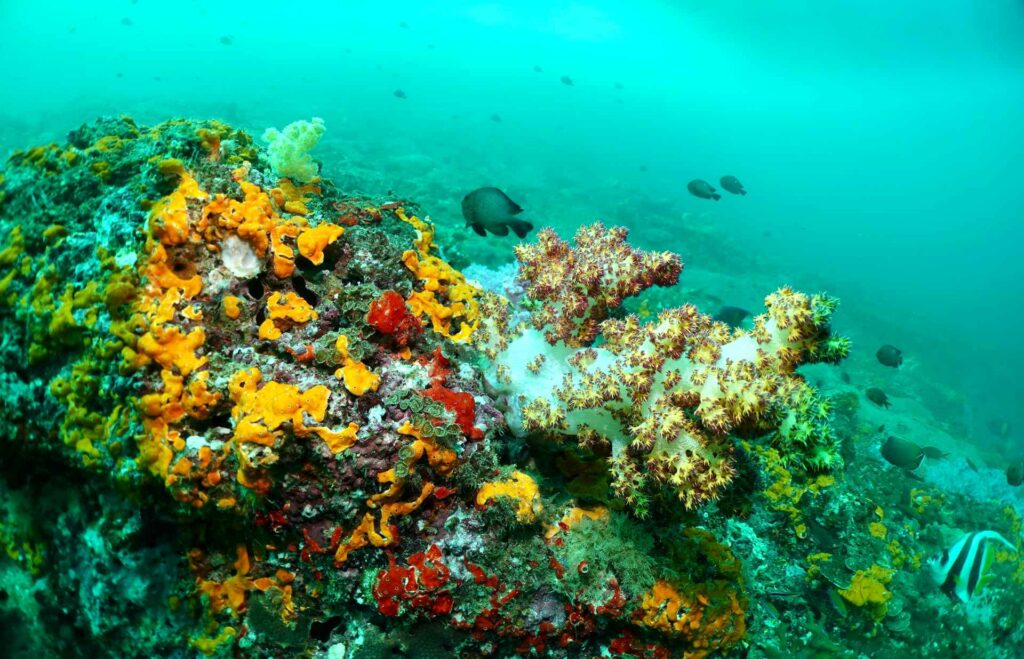
Big sweetlips and snapper are found amid clouds of the red-tooth (blue) triggerfish (Odonus niger) with their white tails. Big painted lobsters hide under ledges and Arabian picassofish (Rhinecanthus assasi) wander about.
On the east side of the island, Abu Rashid wall’s conspicuous drop-off has a thermocline at 15m, where cold water wells up to create a sudden blur layer, and the water temperature drops to 26°C.
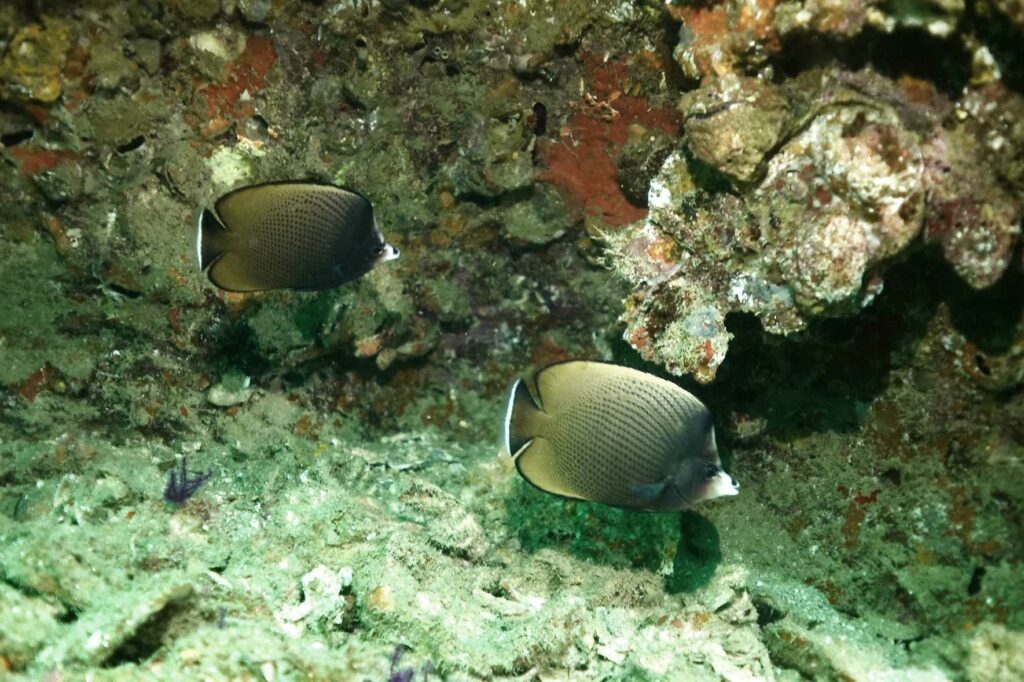
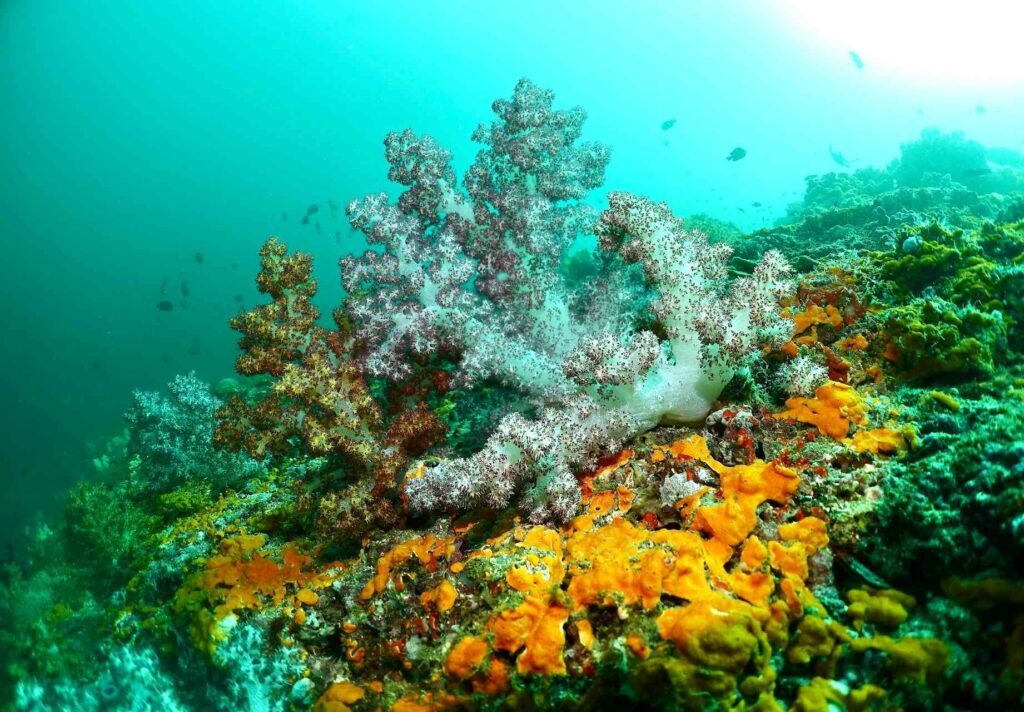
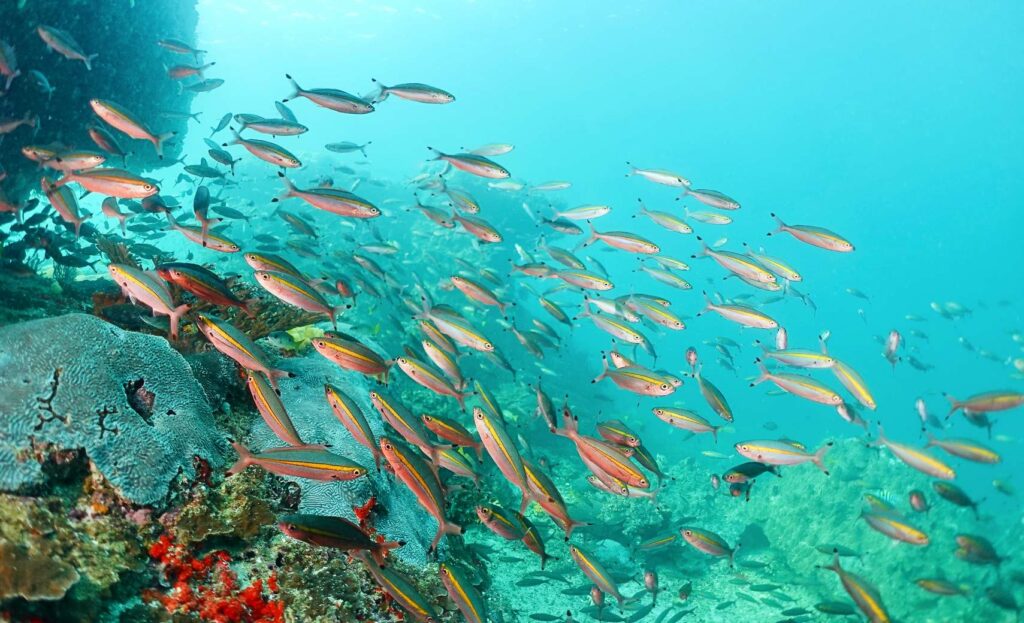
For the fourth time in four days, I have to miss a second dive because I can’t clear my left ear. I suspect a bacterial infection from algae, but ear-drops are offering only mixed results.
While not diving, it’s worth heading west along the coast to Qiba and inland to Tawi village, where 3,500-year-old rock engravings of hunters mounted on horses and camels can be seen on boulders beside the road.
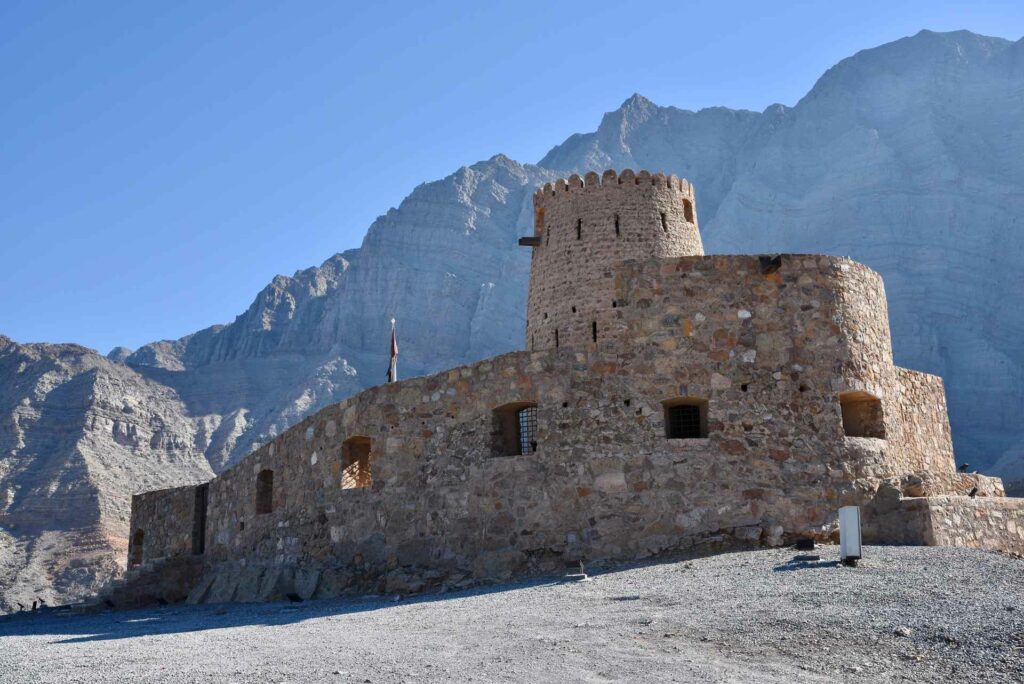
Along the coast road to Dubai, the old fort of Al Bukha perches on a hilltop, and on the way back to Khasab a dirt road leads to the top of Al Harf mountain, providing a breathtaking panorama of Musandam’s geological wonders, of Mukhi village to the east and, looking west, the ravishing Persian Gulf coastline and the town of Al Bukha.
On to Muscat
An Oman Air flight takes me back to Muscat, and a one-hour taxi-ride across a rugged mountainous landscape of red and black rock brings me to Jebel Al Sifah.
An artificial paradise in the middle of nowhere, this is a retreat for idle holidaymakers with luxury tastes, but pools and marinas are not my kind of heaven.
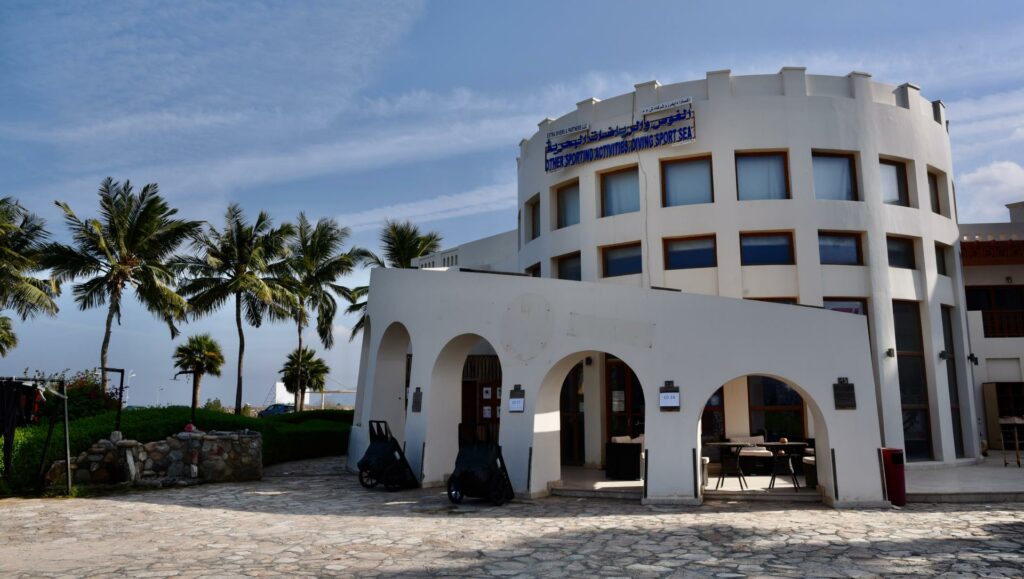
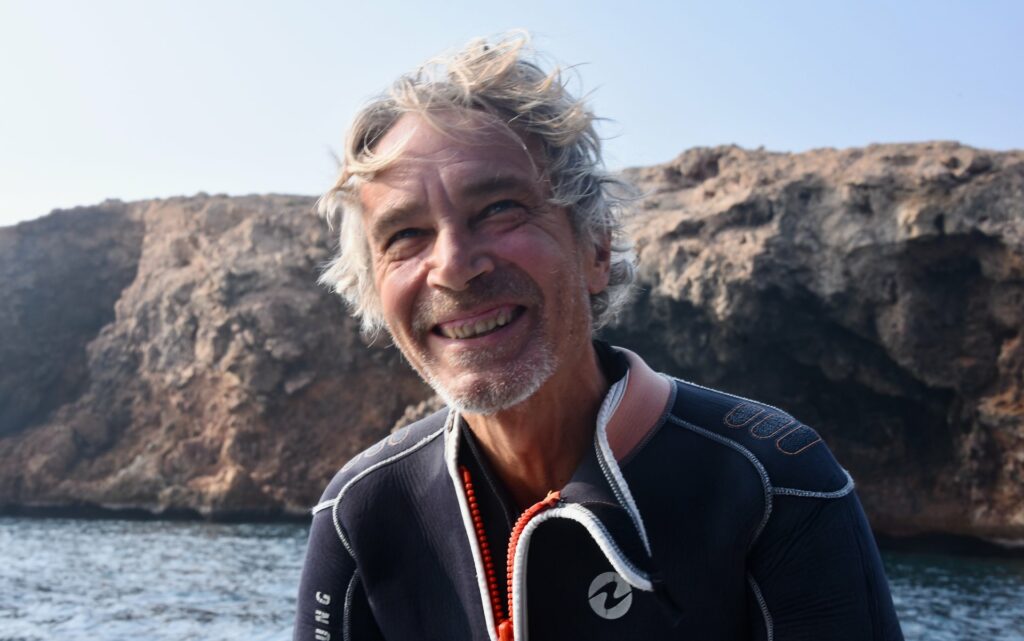
The Extra Divers dive-centre is a 10-minute walk in the sun beside the glittering waters of the marina. Swiss manager Guillaume Chapuis greets me. With his combed-back blond hair, salt & pepper beard and square chin, he puts me in mind of Davy Crockett.
“I’m on my way to lunch,” he says, and we enjoy a good chat. Guillaume was a banker, but abandoned high finance initially to run a dive-centre in Malta.
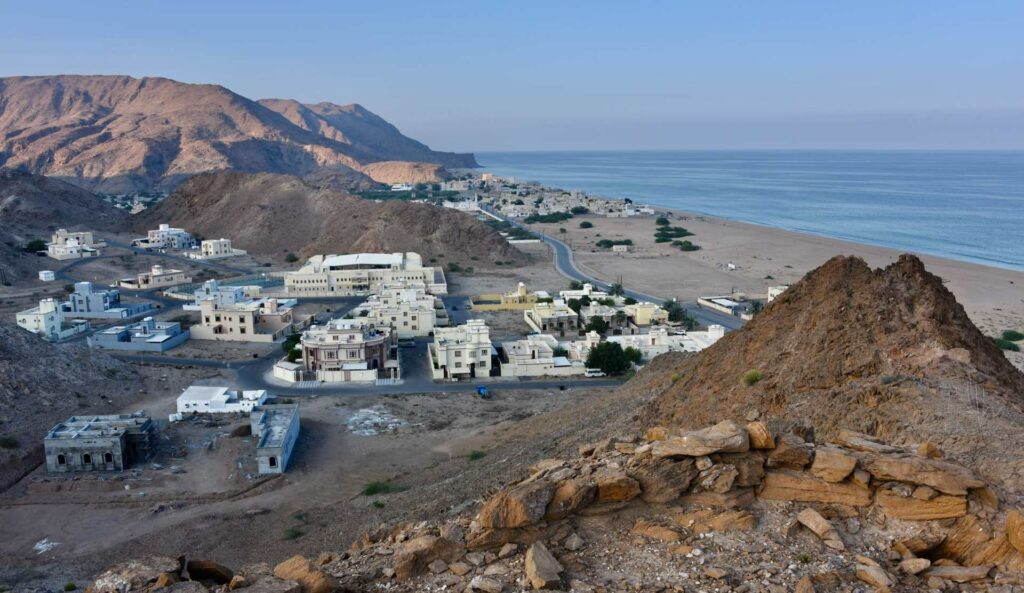
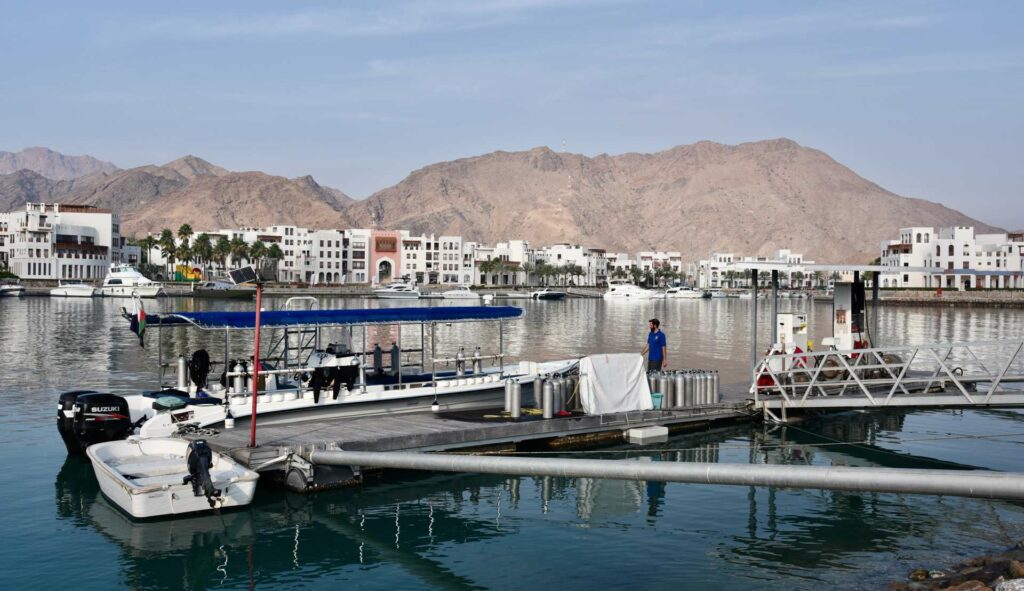
Al Sifah, on the Gulf of Oman, covers three areas: the Abu Daud Islands to the south-east, Bandar Al Khairan to the west and, much further away in the blue, Fahal Island, which requires the right sea and weather conditions. There are some 30 dive-sites to explore.
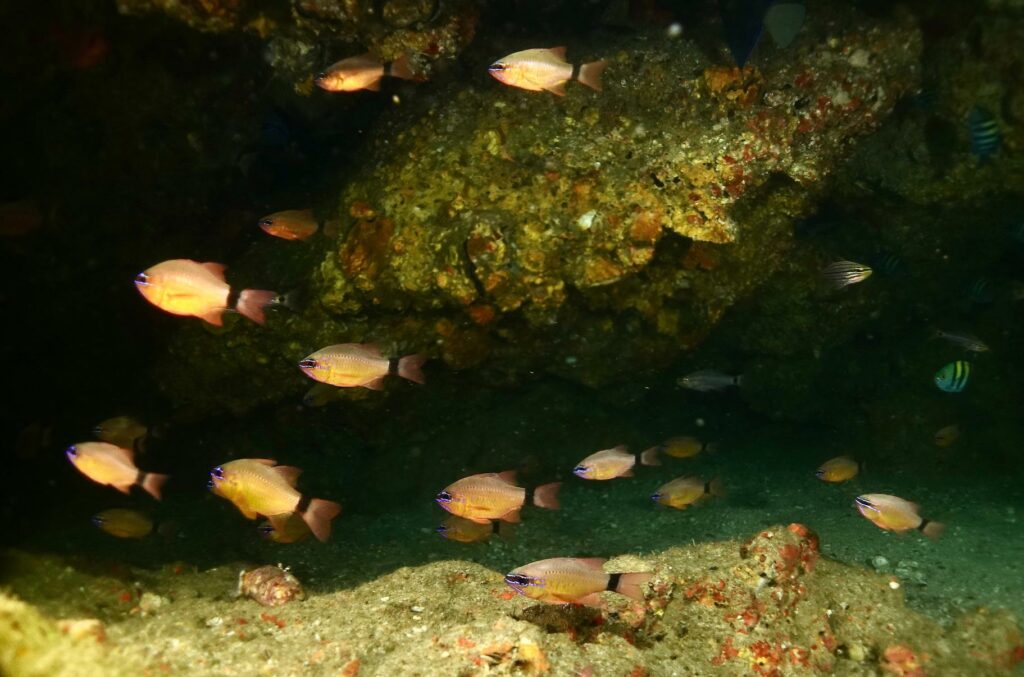
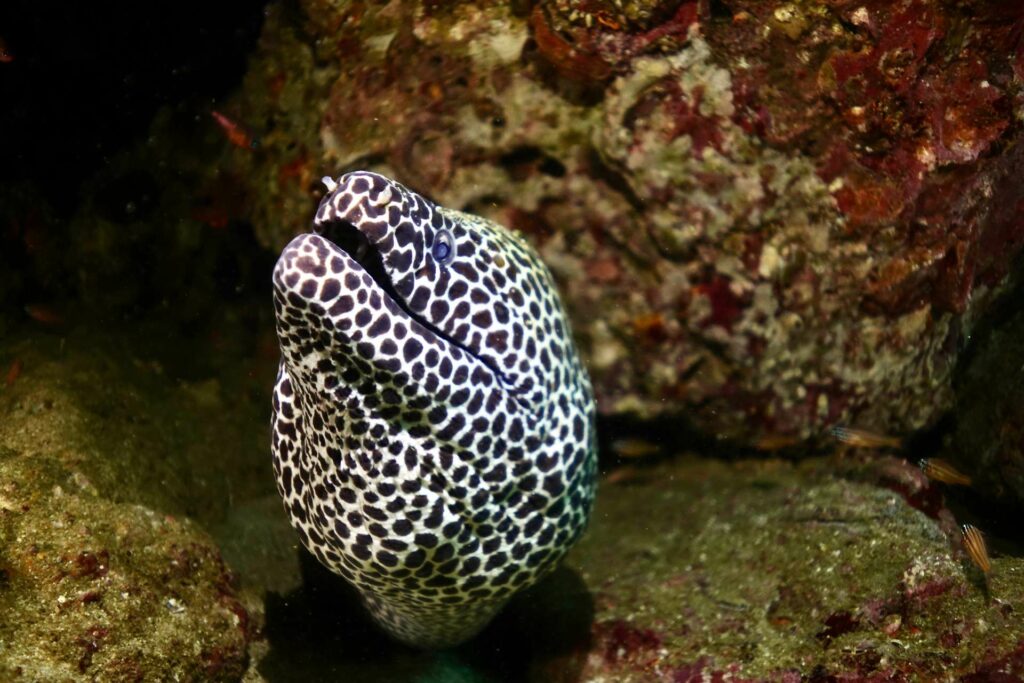
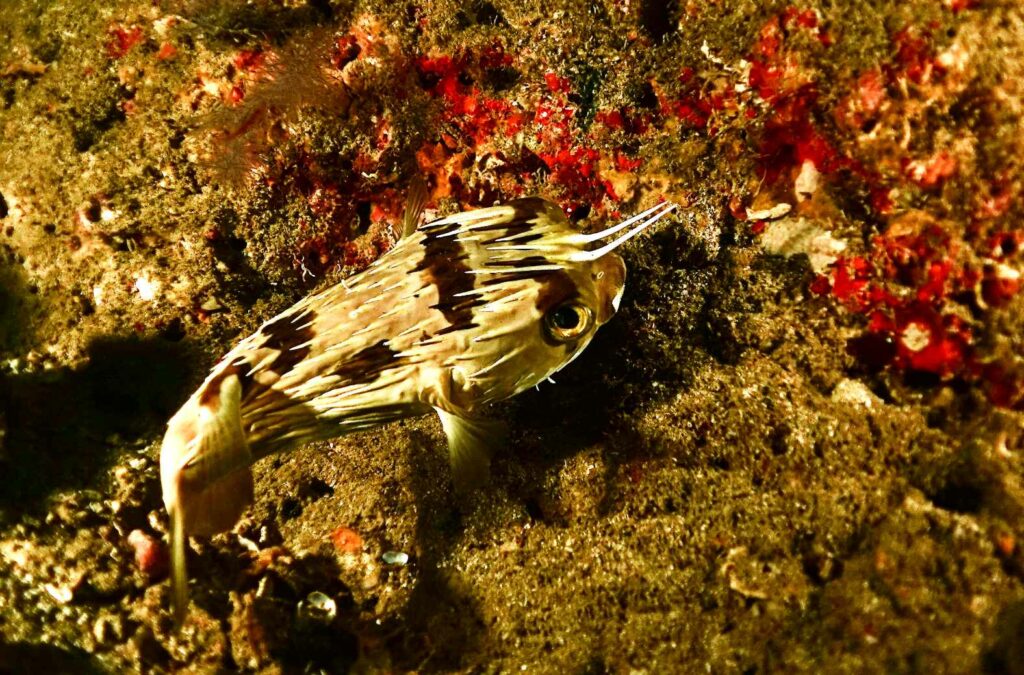
The two main sites at Abu Daud are West Corner and East Corner. The elongated island attracts great blue herons above and, below, schools of golden cardinalfish (Apogon aureus) that hover in small caves. Charged with plankton, the green waters are subject to a slight current from the south-east.
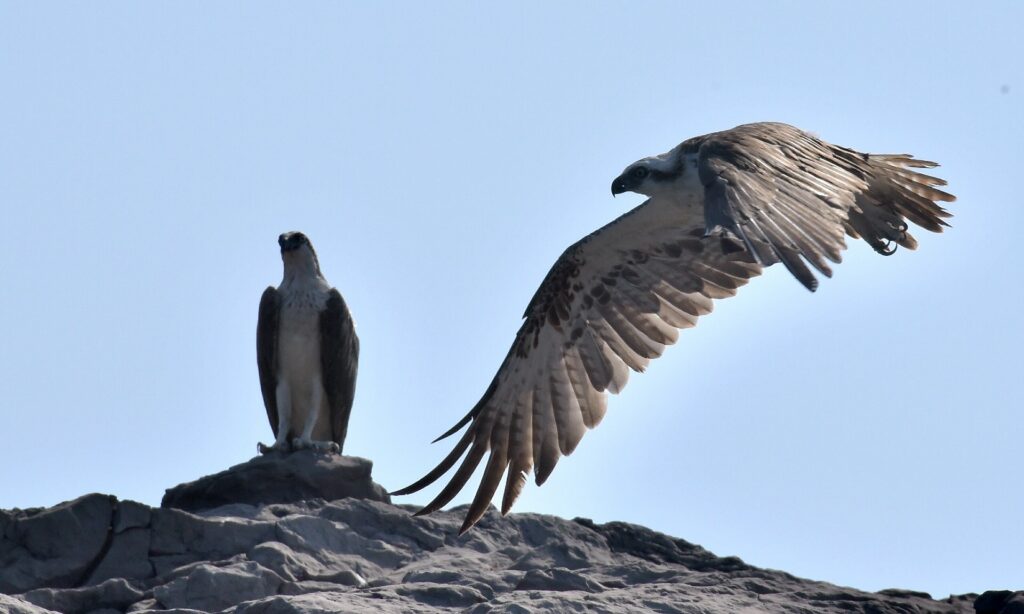
I come across Gardiner’s butterflyfish (Chaetodon gardineri), the laced or honeycomb moray, Sohal surgeonfish, redtail butterflyfish (Chaetodon collare), yellowtail tang (Zebrasoma xanthurum) in royal blue and black-spotted sweetlips (Plectorhinchus gaterinus).
The pretty Arabian picassofish is always wary of photographers. A little school of speedy diamondfish (Monodactylus argenteus) zoom back and forth.
First Entrance
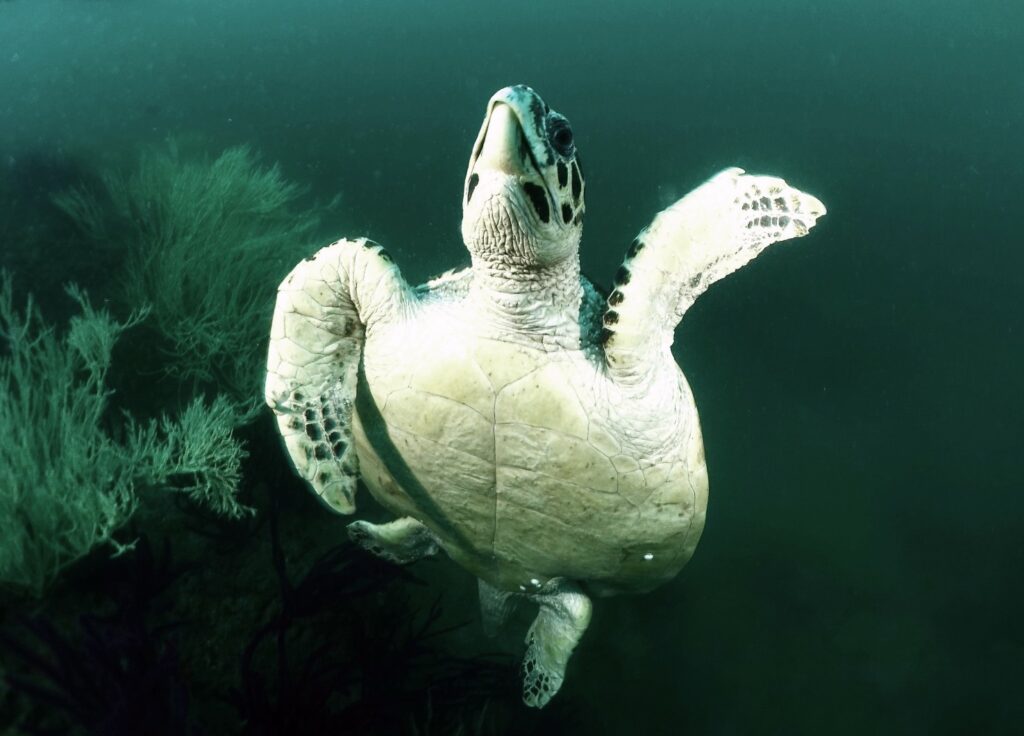
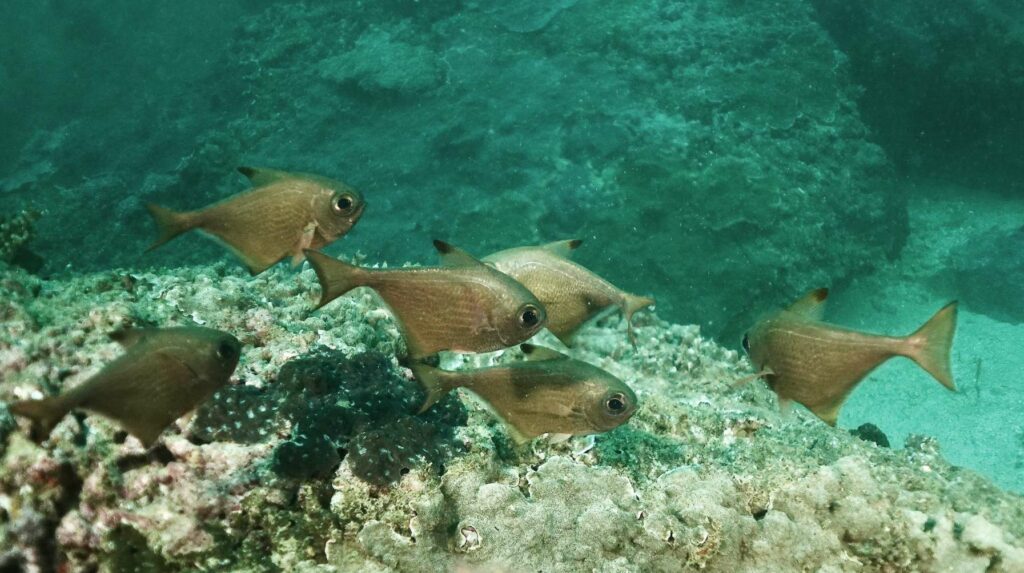
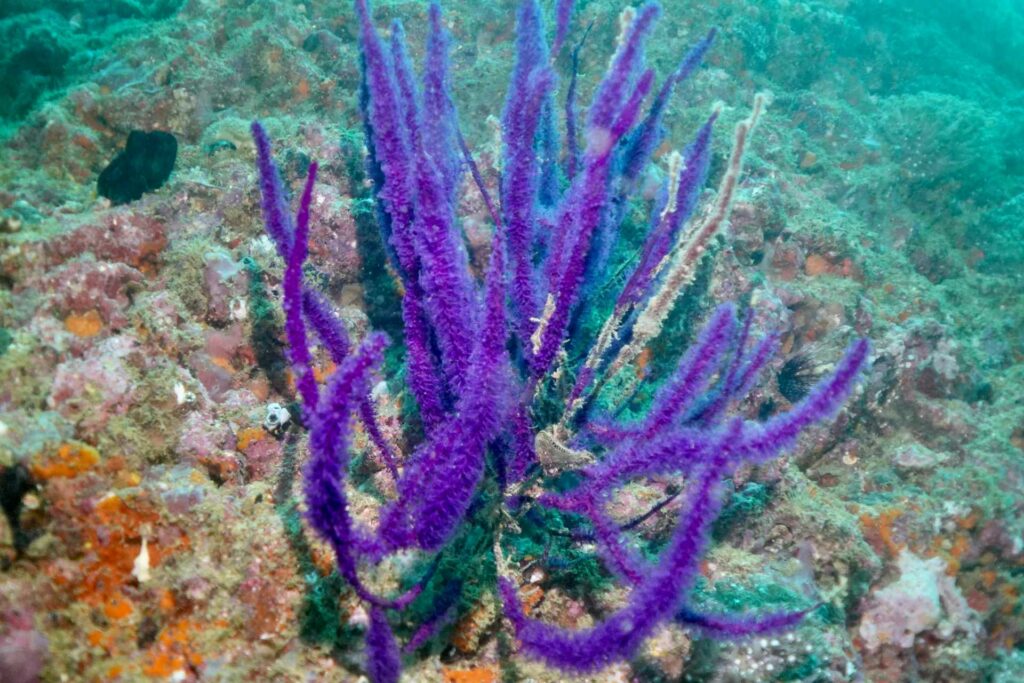
The First Entrance site in Bandar Al Khairan is a mix of boulders on a white sandy bottom. Finnish instructor Anna Sara points out a marbled torpedo ray (Torpedo sinuspersici) that inspires respect.
Numerous yellowspot burrfish (Cyclichthys spilostylus) rest on the slope. A forest of black coral conceals a large hawksbill turtle munching on yellow polyps. A school of bigeye snapper (Lutjanus lutjanus) hover about, together with Arabian monocle bream. A few flower sea urchins (Toxopneustes pileolus) dot the sand, complete with attached pieces of shell.
Mermaid Cove offers a similar seascape. Between purple gorgonians, a green turtle is dozing on a rock. Two Hypselodoris pulchella nudibranchs cruise in tandem on a boulder face.
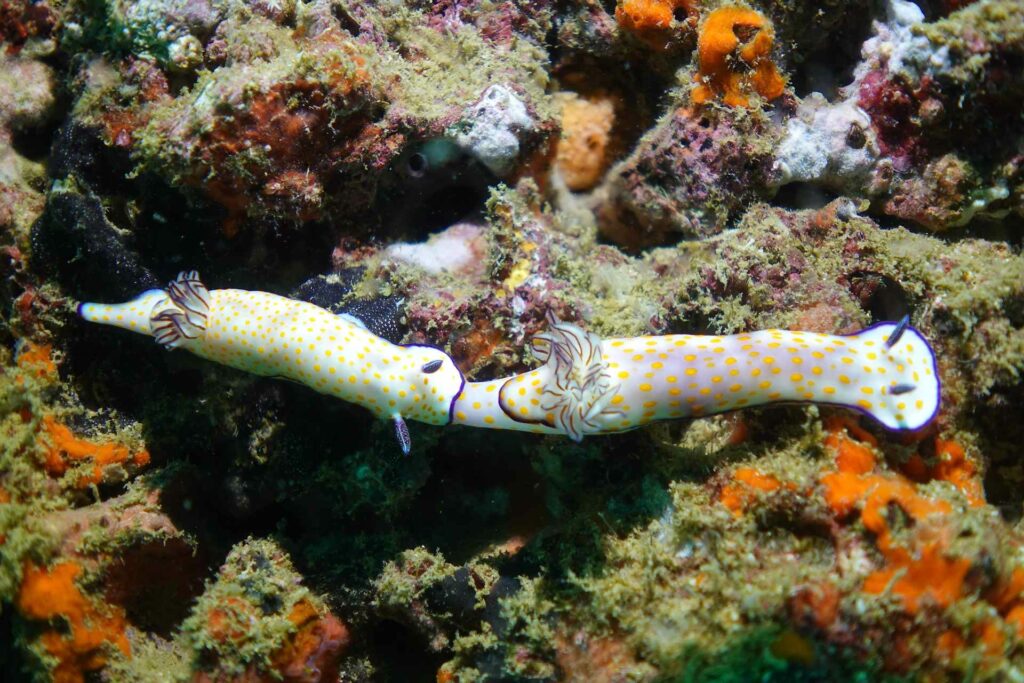
Over a sandy patch, two cuttlefish engage in a courtship display.. Blacktip jack (Caranx heberi) flash by towards the end of the dive along the rock face, and a vast field of Sarcophyton soft corals carpet the shallows.
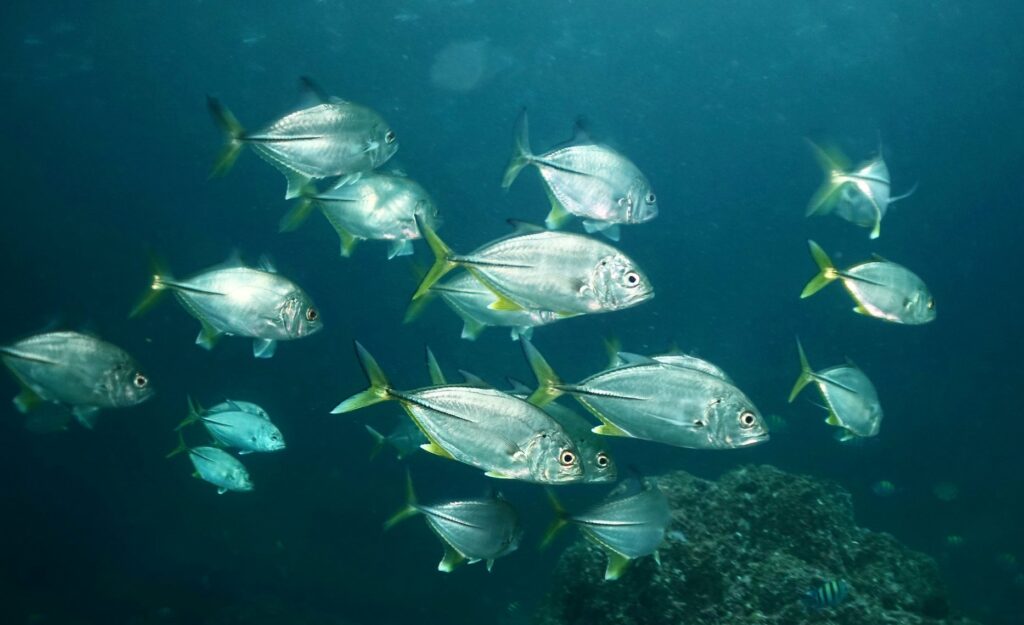
Al Munassir wreck
The 84m British-built amphibious warfare vessel Al Munassir was launched in Glasgow in 1978. Sold to the Oman Navy as a carrier for helicopters and small vehicles, she was in service for 25 years.
Sunk in 2003 near Al Khairan, the wreck now sits upright in 25m. Visibility is great here, as is the marine life. Richard, the Irish dive-guide, takes me from bow to stern. The winch area is full of colourful Dendronephthya soft corals and teems with golden cardinalfish, redtail butterflyfish, yellowbar angelfish and more.
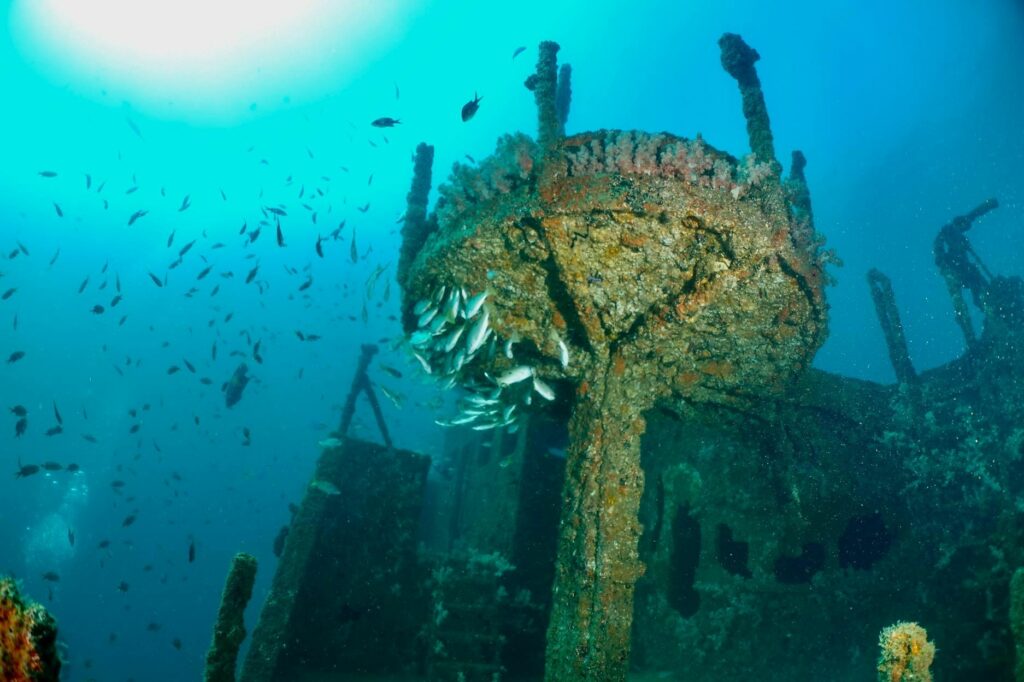
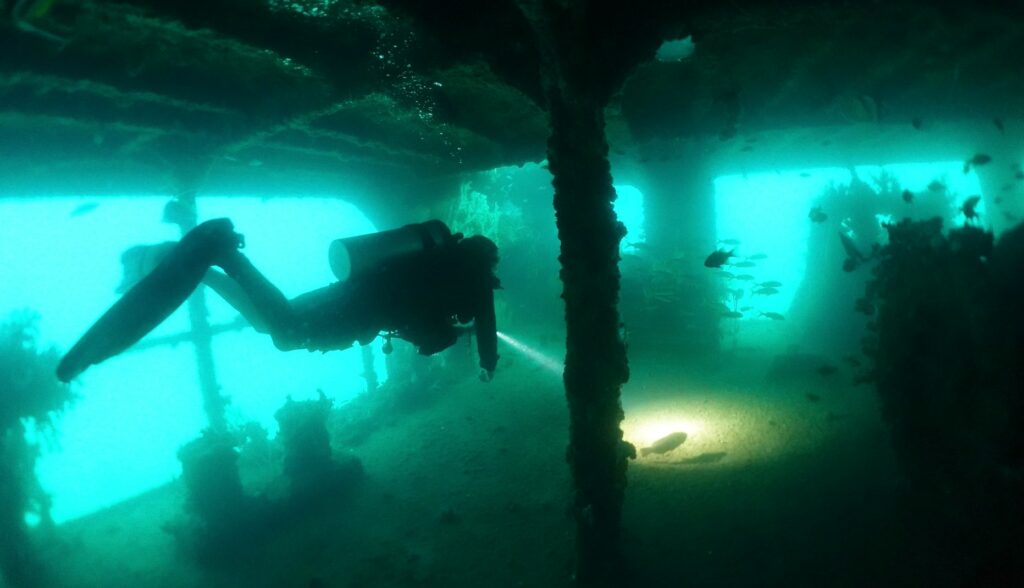
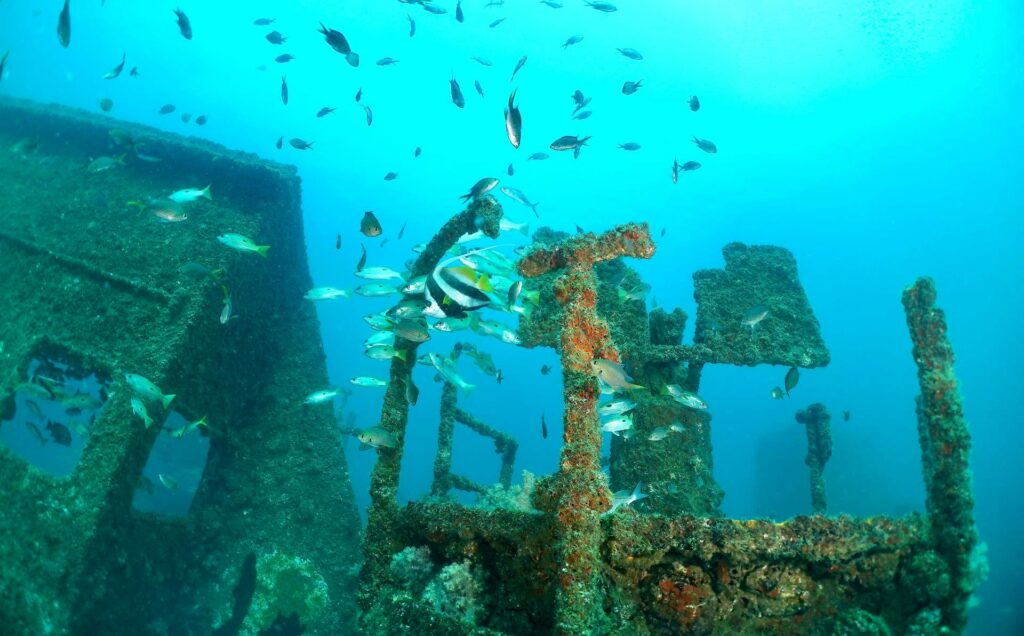
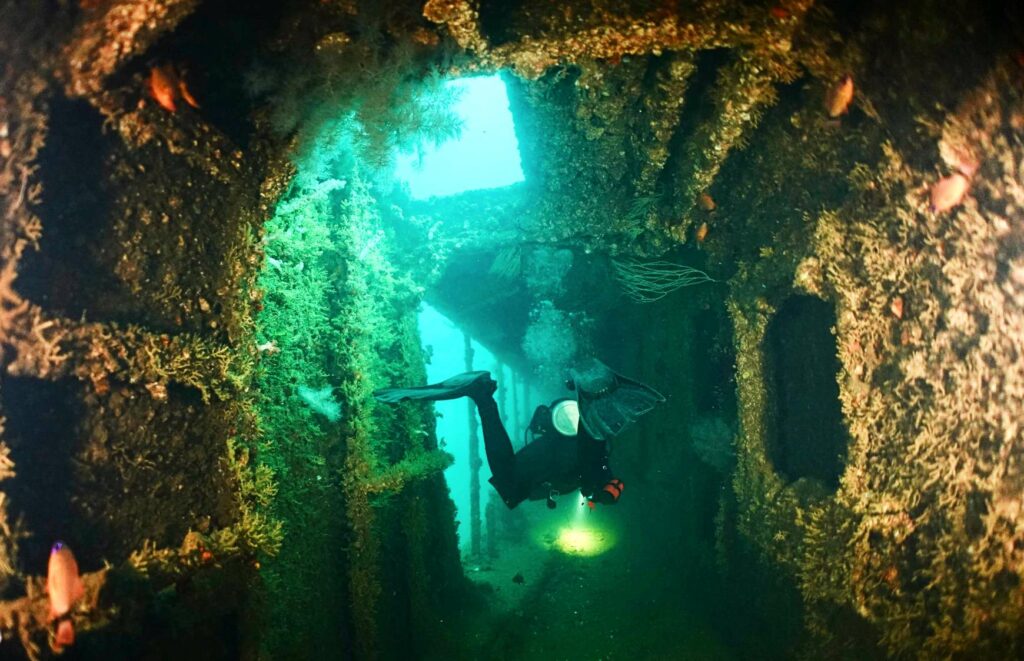
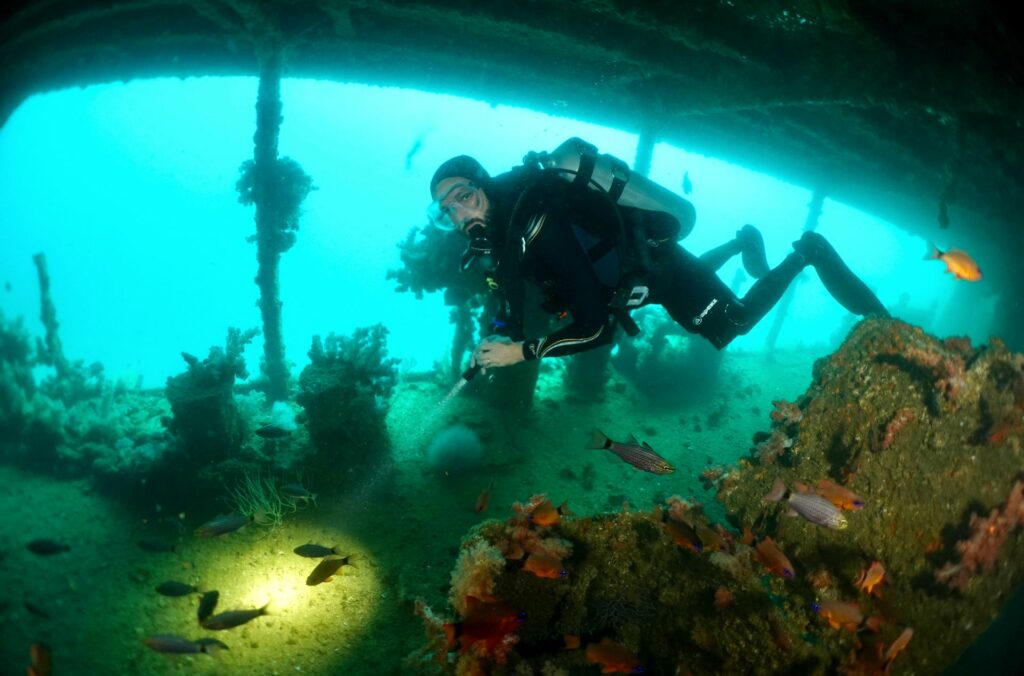
Dark and silty, the nearby deep hold was a helicopter garage. We cruise along the gangway on the port side, exposed to the sun’s rays. Various penetrations inside provide an eerie atmosphere, as beams of light gush through the portholes.
Schools of long-spot and big-eye snapper flutter about the gun emplacements and superstructure. Male and female blue-tail trunkfish (Ostracion cyanurus) show no fear as we approach.
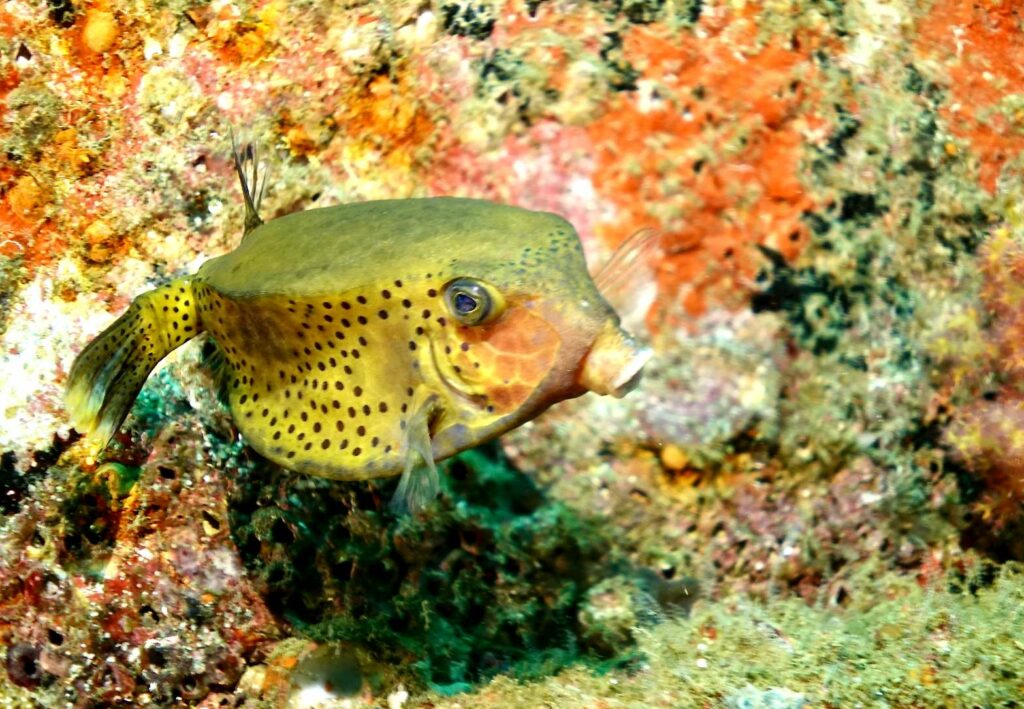
Before I rise to the safety stop a honeycomb moray slips out of hiding to meet me, joined soon afterwards by an equally inquisitive grey moray (Siderea grisea). This last image sums up perfectly for me both the thrill and enchantment of diving in Oman’s waters.
“I know it’s not the last time we’ll see each other,” concludes Guillaume on the morning of my departure. Now Oman’s great south is beckoning…
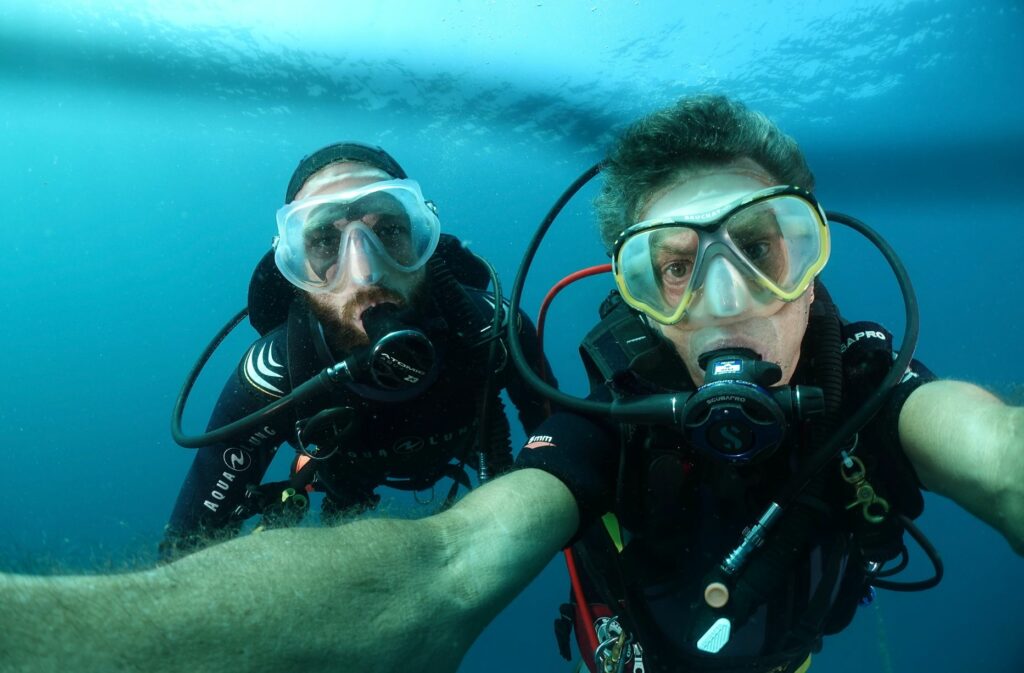
Find more about Musandam Discovery Diving and Extra Divers Sifah and what they can offer divers in Oman on their websites. Pierre Constant runs Calao Life Experience
Also on Divernet: Oman: A hidden diving gem
